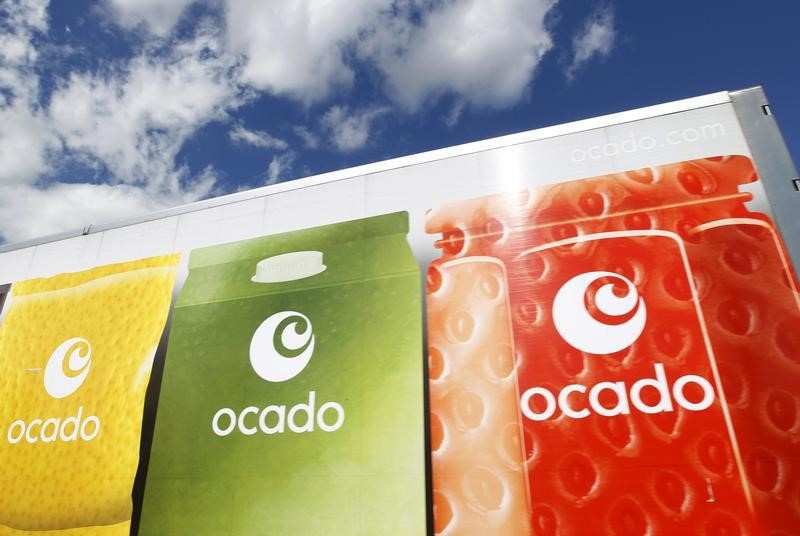* Andover warehouse is most cutting-edge yet
* Operates with 600 robots
* Has helped Ocado win three major deals in six months
* Expects to sign multiple deals in medium term
* Ocado shares up 117 percent year-on-year
By James Davey
ANDOVER, England, May 9 (Reuters) - As 600 robots swarm on a grid overhead, the technology boss of British online supermarket pioneer Ocado OCDO.L explains why its new high-tech plant has caught the attention of the world's retail bosses who are racing to crack internet food shopping.
Supermarkets around the world are struggling to develop a sustainable system that delivers food to customers. In the last six months three of the biggest have turned to Ocado, set up by three former Goldman Sachs (NYSE:GS) bankers 18 years ago. deals followed the development of Ocado's 240,000 square foot distribution centre in Andover, southern England, that pulls together an average order of 50 items in a matter of minutes as opposed to the several hours taken by its older centres.
Ocado says Andover, powered by its own software and hardware, is the most advanced system for online grocery on the planet. While boosting its own profitability, it also functions as a shop window to potential customers and the three deals have helped send its share price up by 117 percent in a year.
"We are talking to people across literally every continent apart from Antarctica," said Paul Clarke, Ocado's chief technology officer.
Last week's 7.3 billion pounds ($9.9 billion) agreed bid by Sainsbury 's SBRY.L to buy Walmart's WMT.N Asda was in part a response to the growth of online retail, particularly the relentless march of Amazon AMZN.O . around the world are experimenting with different ways of picking online grocery orders, seeking to balance speed with cost as ecommerce takes off for food.
Ocado's recent partnerships have been lapped up by those investors who view it as central to the development of grocery shopping. Sceptics see only a costly and complicated venture that will never make sustained profits.
That risk is baked into the share price -- Ocado trades on a ratio to current earnings of 2,258 compared with 17 for Britain's biggest retailer Tesco TSCO.L .
ROOKS ON A CHESSBOARD
U.S. players such as Walmart (NYSE:WMT) WMT.N are focusing on cheaper low tech warehouses as they can afford more of them, closer to customers, rather than the high tech sheds favoured by Ocado and Chinese players.
Dutch supermarket group Ahold AD.AS , for example, has developed a low-cost centre that has a picking rate of 135 items per hour, according to brokerage Bernstein - far slower than Ocado but without the high capital investments in technology.
Ocado has struck deals for its Ocado Smart Platform (OSP) with France's Casino CASP.PA , Canada's Sobeys EMPa.TO and Sweden's ICA Group ICAA.ST so they can develop their own e-commerce operations.
Ocado will build warehouse facilities and provide all the end-to-end software - effectively offering a one-stop shop for the partners' online grocery operations.
At the heart of the system will be replicas of the robots that can be found hidden away in Andover, racing around a grid.
The plant is Ocado's third automated warehouse, or customer fulfilment centre (CFC). Where the first two required humans to load thousands of crates travelling on miles of conveyor belts, Andover has 600 robots whizzing around at four metres a second. It will have 1,100 when at full capacity.
The robots run on two huge extruded steel and aluminium grids - one for chilled products and another for ambient goods.
"The robots are like rooks on a chessboard," Clarke said, adding that they are given instructions about 10 times a second and collaborate as a swarm.
Under every chess square is a stack of up to 21 containers holding groceries. Together the stacks make up the body, or "hive", of the grid.
The robots stop on a square, lower a grabber and pick up a container. They bring the container up into a cavity in their body, then move to drop it off at another stack on a nearby square or move it to the periphery of the grid, where humans fulfil the orders by packing the goods into bags. Containers then shoot them back into the hive for despatch to customers.
Andover, where 300 people work inside the warehouse, is also proving attractive due to its size.
While it will eventually have an annual capacity of about 350 million pounds and some 65,000 orders per week, that's still about one third of Ocado's older site in central England.
The smaller size is appealing to those retail bosses operating in more nascent online markets, and Ocado will use the same technology but on a bigger scale at its next plant in Britain, where 42 percent of shoppers go online for at least some of their groceries, according to industry group IGD.
STARTING SMALL
"We needed a solution that could scale," said Clarke. "(Partners) may need to start small in a territory where online grocery is not as evolved," he said.
"So rather than building a huge facility all in one go, you might want to build it more incrementally and scale-up capacity and capital investment over time."
Ocado's own capital expenditure has been rising – 210 million pounds is forecast for 2018, up from 160 million pounds in 2017.
Ocado's shares have had a rollercoaster ride since listing at 180 pence in 2010. They were trading at 564 pence on Tuesday, valuing the business at 3.7 billion pounds.
Bernstein analyst Bruno Monteyne says the valuation implies 15 platform deals and 17 software deals.
For now, the company itself is confident of further success.
"It took time for us to sign the first few but now we have a lot of work in progress, there's a lot of companies that we're talking to," Clarke said. "We expect to sign multiple deals in the medium term." ($1 = 0.7408 pounds)
